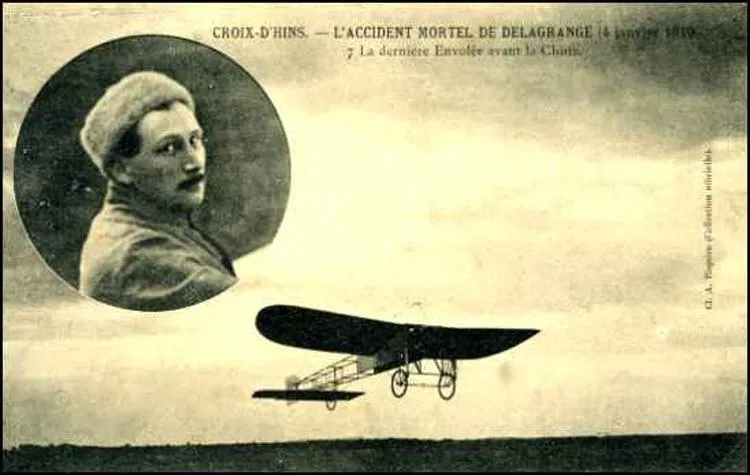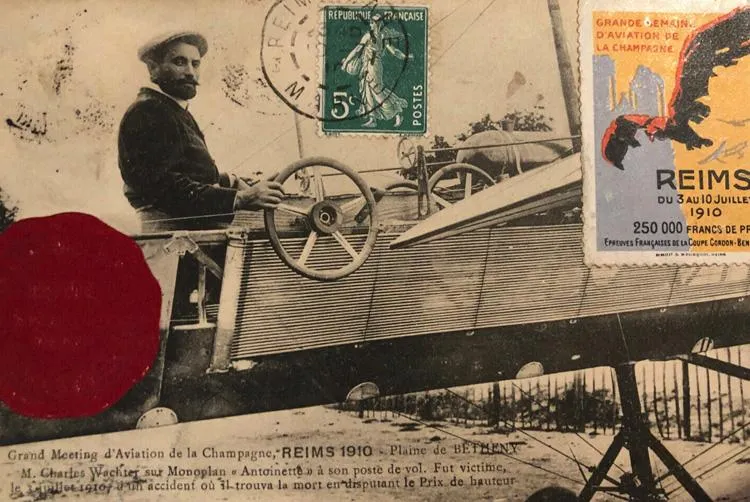After Thomas Selfridge
Many people know who the first aircraft fatality was. But who was the next, and the next?
/https://tf-cmsv2-smithsonianmag-media.s3.amazonaws.com/filer/f8/ab/f8abe4b7-71d3-4e4b-aa87-fa77d709fadf/100515-o-zz999-404c.jpg)
On September 17, 1908, Lieutenant Thomas E. Selfridge—the first person to die in an airplane crash—shed his coat and hat and climbed into the Wright Military Flyer next to pilot Orville Wright. The men were conducting a demonstration flight for the U.S. Army Signal Corps at Fort Myer, Virginia. Spectators that day noted that the aircraft didn’t rise as quickly as it had during earlier two-man flights, possibly because at 175 pounds, Selfridge was heavier than previous passengers. As the airplane circled above the drilling grounds, the right-hand propeller broke, starting a sequence of events that ended with the aircraft hitting the ground nose-first. Selfridge was the first fatality in a powered, heavier-than-air craft, and his death made front-page news around the world. The New York Tribune called it “the most severe setback that aeronautics has ever received,” coming at a time “when men and nations were ready to accept the proposition that the problem of heavier than air flight had not only been solved, but that commercial and military uses would be found soon for machines already developed.”
Although Selfridge’s death was the first, it wouldn’t be the last. With each new fatality, newspapers and magazines printed lists of the fallen aviators. The lists didn’t always match, however, in part because the reports came from different countries. As the April 1910 issue of Aircraft notes, European publications often mistakenly reported well-known American pilots to be dead. Early Wright pilot Walter Brookins, who would live to age 63, frequently made the list. So did early aviator Henry W. Walden, who didn’t die until 1964, at the age of 81. American sources had the same difficulties confirming the deaths of non-U.S. pilots.
Despite these pitfalls, it’s still possible to reconstruct a list of the first people after Selfridge to die in airplane crashes. Here they are, in order:
Eugène Lefebvre
/https://tf-cmsv2-smithsonianmag-media.s3.amazonaws.com/filer/5b/fa/5bfa59cc-0ea4-4c9e-9c40-06a7fbe43e5e/1024px-eugene_lefebvre.jpg)
The second person to die in an airplane crash was French aviator Eugène Lefebvre, chief pilot for the French Wright Company. He was killed on September 7, 1909, when the aircraft he was testing crashed at Juvisy-sur-Orge. The New York Times reported that the cause of the accident was unknown; Lefebvre had been testing the airplane prior to delivering it to a buyer. “One of these [aircraft] had already been successfully tested, and just before nightfall Lefebvre took out another. The machine left the ground easily and flew around the aerodrome at a height of about 20 feet, making the turn gracefully. Suddenly, without any apparent reason, it tilted sharply downward, and, propelled by the force of the motor, struck the ground with great violence.” The Times went on to describe Lefebvre as something of a daredevil: “He was an engineer of considerable note, and became interested in aviation through studying it as a science. He has been known for his daring performances and recklessness. During one of the Rheims races he was fined $4 for reckless flying.”
Louis Ferdinand Ferber
/https://tf-cmsv2-smithsonianmag-media.s3.amazonaws.com/filer/a1/75/a1757b20-ff4a-481e-bc4c-ceba1fc9dc45/captain_ferdinand_ferber.jpg)
French aviator Louis Ferdinand Ferber became interested in gliders in 1898 and went on to build airplanes of his own design after corresponding with the Wright brothers. According to thefirstairraces.net, in 1906 Ferber, an Army captain, took leave from the military and began working at the Société Antoinette, building gliders and eventually powered aircraft. In 1909 he bought a Voisin and began competing in air races, using the pseudonym “F. de Rue” to protect his military career. He was killed on September 22, 1909, when he was hit by the engine of his Voisin after it nosed over after crashing in a ditch.
Some sources list an Italian aviator named Enea Rossi, not Ferber, as the third aircraft fatality, citing a death date of September 7, 1909. But due to scanty evidence, differing spellings of both his first and last names, and any corroborating evidence, Rossi does not appear on later compiled in Flight, the 1911 World Almanac, and Aircraft.
Antonio Fernández Santillana
On December 6, 1909, Spanish aviator Antonio Fernández Santillana’s airplane engine exploded at 1,000 feet; he was killed in the resulting crash. The Hartford Courant noted that Fernández was working as a tailor in Nice, France, when he became interested in flight. Using his tailoring skills, he constructed a biplane “resembling in a general way the models of the Wright brothers. Fernández exhibited his machine at Rheims during the exhibition there last summer, but was unsuccessful in his efforts to accomplish a flight of any consequence.” The Chicago Daily Tribune reported that Fernández’s death was caused, in part, by “the inexperience and recklessness of the aviator, who, impatient at the delay and not heeding the expostulations of his mechanician, patched up a defective part of the machine by binding it with common twine. He was convinced that his machine, which resembled the Wright and Curtiss machines, was superior to any other.”
Ferdinand Léon Delagrange

Ferdinand Léon Delagrange of France was one of the best-known pilots in Europe, and is credited with being the first to take a woman—Thérèse Peltier—aloft on July 8, 1908, in Milan. (Peltier, taught by Delagrange, would solo just two months later.) Delagrange set several speed and distance records, participated in the world’s first air race (at Port-Aviation on May 23, 1909), and was a frequent contestant at air meets. He owned and flew Voisins and Blériots, and his death in a Blériot on January 4, 1910, was front-page news around the world, partly because it was the first fatality in a monoplane. The Knoxville, Tennessee Daily Journal and Tribune reported that during the air meet in Bordeaux, Delagrange circled the field repeatedly, even during strong wind gusts. On his third round, he entered a turn; “The machine was seen to sway. The left wing was broken and the right wing immediately collapsed.”
Another French aviator, Hubert Le Blon, would become the sixth airplane fatality when his Blériot experienced the same type of mechanical failure on April 2, 1910. It would take another two years before the company would modify its flawed wing design.
Gabriel Hauvette-Michelin
/https://tf-cmsv2-smithsonianmag-media.s3.amazonaws.com/filer/31/46/3146dd51-6b0c-40e9-83a3-699062c9b54e/hauvette_michelin.jpg)
The nephew of Édouard Michelin (of tire fame), Gabriel Hauvette-Michelin was killed in his Antoinette at the Lyon air meet in May 1910. Just a few months earlier, Hauvette-Michelin participated in the first flight above Egypt, in the same aircraft. Historian Gary Leiser includes a description of Michelin’s aircraft, written by a reporter for al-Mu’ayyad: “It is composed of a long narrow boat sitting on two wheels. In the front are two oars of copper. On each side are two long wide wings of wood, cloth, and wire. It has a tail like that of a fish.” During the February 1910 meet in Egypt, Hauvette-Michelin briefly went aloft before crashing, but the pilot was unhurt. The aviator’s identity was long a mystery; “Anders,” who left a comment on theaerodrome in 2015, was able to track down both Hauvette’s first name (never mentioned in newspaper reports of the time), and his date of birth. During the Lyon meet, the left wing of Hauvette-Michelin’s Antoinette hit the pole of a pylon; the aircraft crashed, and the pole fell, hitting the pilot on the head and causing his death.
Thaddäus Robl
/https://tf-cmsv2-smithsonianmag-media.s3.amazonaws.com/filer/40/25/40259a57-0369-4e1c-9de6-02219b229a54/robl.jpg)
The first German fatality, Thaddäus Robl was killed in a Farman biplane on June 18, 1910, near Stettin, Germany. Robl was a famous cyclist who became interested in aviation after retiring from cycling. While flying in gusty conditions, he fell from the aircraft to his death.
Charles Wachter

French aviator Charles Wachter was killed in a crash at the July 3, 1910 Rheims air meet. He was descending when spectators heard an explosion, and the wings of his Antoinette monoplane folded. Wachter was a mechanic, notes thefirstairraces.net, and had been flying for only two months before entering the air meet. Michel Efimoff flew the final flight of the day, and was criticized for “flying above the corpse of his comrade.”
Daniel Kinet
/https://tf-cmsv2-smithsonianmag-media.s3.amazonaws.com/filer/6b/61/6b61ba1a-5a47-4436-84fd-a9dfc474a16f/kinet.jpg)
Belgian pilot Daniel Kinet began his aviation career as a balloonist, finishing third—at age 19—in a competition in Ghent. By 1910 he was a student of Henri Farman, in France, obtaining his pilot’s license on February 1. According to peoplepill.com, just weeks later Kinet was a chief pilot at the Mourmelon flight school. He set several records by the time he arrived at the Ghent air meet on June 24, 1910, with his Farman biplane. His plan was to give demonstration flights each day, with and without passengers, for the duration of the air meet. Accounts of his accident differ, but on July 10, while making his third flight of the day, he either had engine problems, and/or the wings and tail broke from his aircraft. Losing control, Kinet crashed into a tree. He was taken immediately to a hospital, and died of his injuries five days later.